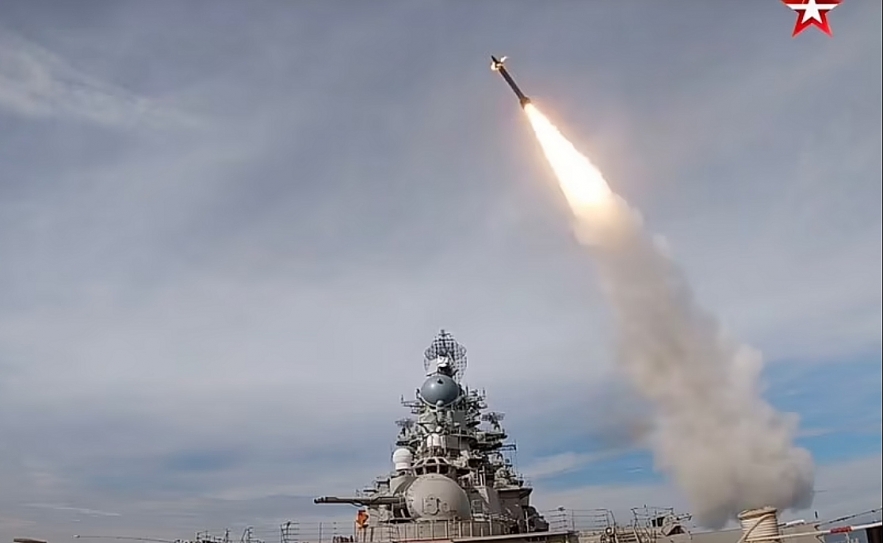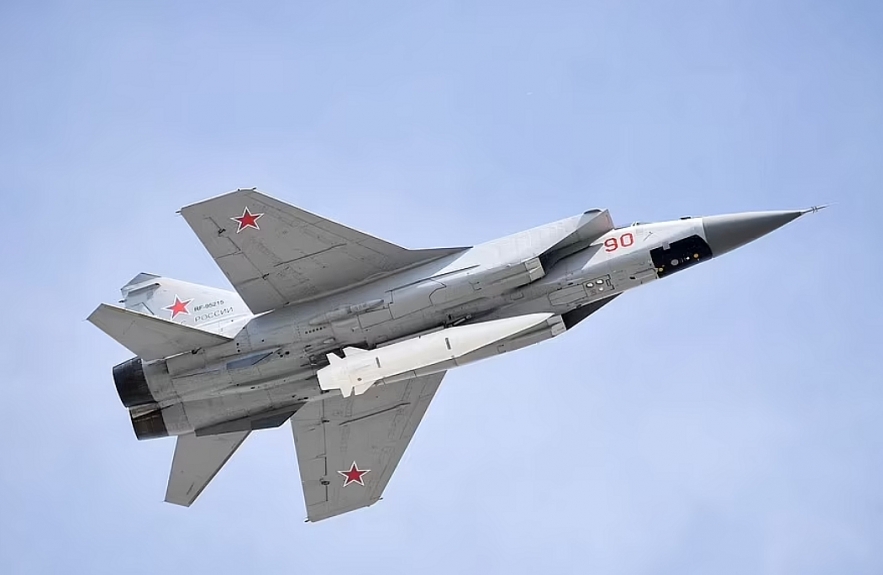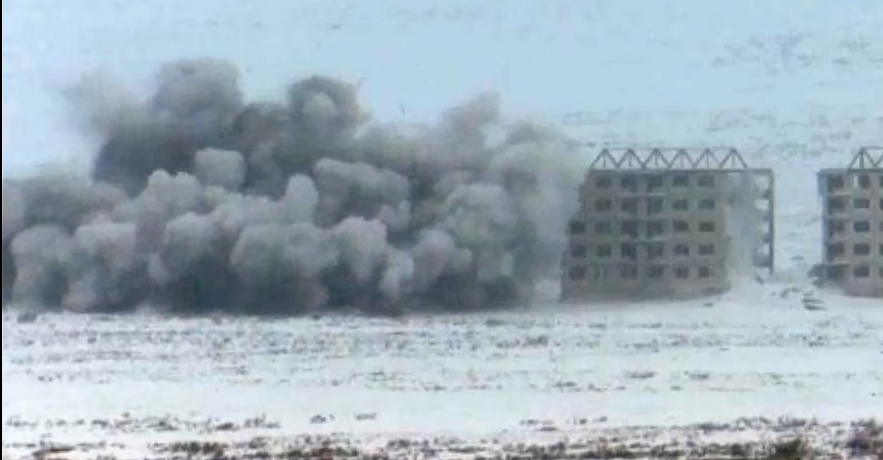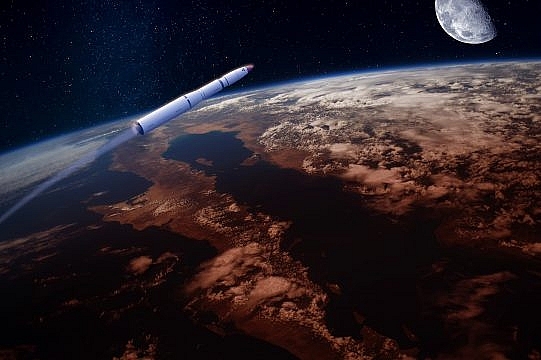What is Russia's Kinzhal Missile and How Powerful of Hypersonic Missile in Ukraine
 |
| Kinzhal hypersonic missiles of Russian Army |
Russia has used its newest Kinzhal hypersonic missiles for the first time in Ukraine, March 19. 2022 to destroy a weapons storage site in the country’s west, the defence ministry said.
Watch Video - Russia Launches New Kinzhal Hypersonic Missile:
Russia has never before admitted using the high-precision weapon in combat, and state news agency RIA Novosti said it was the first use of the Kinzhal hypersonic weapons during the conflict in Ukraine.
How is Kinzhal Strong and Powerful
 |
| The Kinzhal missile is seen being carried by a MiG-31K during a fly-over of Moscow's Red Square in 2018 |
The Kinzhal (“Dagger”) missile—designated the Kh-47M2 and more recently the 9-A-76609 in Russian sources—has a reported range of 1,240 miles and can carry either an 1,100-pound fragmentation warhead or up to a 500-kiloton nuclear warhead with 33 times the yield of the Fat Man bomb dropped on Hiroshima.
After being launched, Kinzhal accelerates to a speed of 4,900 km per hour and may reach the speed of 12,350 km per hour, it is believed. Kinzhal is believed to have the capacity of hurling a deep strike.
The Kinzhal is capable of precision strikes using a terrain-matching sensor, as well as engaging moving ships at sea using a radar seeker.
A video that played during Putin’s speech depicted a twin-engine MiG-31 fighter launching a large missile. The video included an animation of the missile striking what appeared to be a U.S. Navy warship.
Nine days later, on March 10, the Russian Defense Ministry published a video depicting a separate MiG-31—the fighters are distinguishable by the color-coded numbers on their fuselages—firing the same kind of missile. The test apparently took place near Volgograd in southwest Russia.
“The launch was conducted normally,” the ministry stated. “The missile hit the target at a training ground.”
It’s unclear just how maneuverable Kinzhal is. And that has big implications for its usefulness as a conventional weapon. The surface-launched Iskander rocket, on which Kinzhal is based, can hit targets as far as 300 miles away. Launching from tens of thousands of feet in the air from a fighter flying hundreds of miles per hour lends Kinzhal its much greater reported range of 1,200 miles.
Kinzhal and a Game Changer in Ukraine
 |
| Pictured in this video grab released by Russia's Defence Ministry is the launching of a Kinzhal hypersonic cruise missile during a strategic deterrence exercise by the Russian armed forces |
According to earlier reports, Russia had deployed Kinzal in Kalinigrad, as Russian exclave on the Baltic Sea bordering Poland and Lithuania in February, while it was building up the deployment of its military near Ukraine.
The Kinzhal missile—a modified version of the surface-launched Iskander rocket—could punch right through even the most sophisticated NATO air defenses to strike ships, air bases, ports, and supply depots with a non-nuclear warhead.
That deep-strike capability could give Russian forces a major advantage in the event of war in Europe. “The Kinzhal has no analogues in the world,” the Russian Defense Ministry.
The Kinzhal is a shortened evolution of the ground-launched Iskander. It only works as designed if launched from an aircraft flying very high at extreme speeds, which is how the MiG-31, an aircraft designed as a Mach 3-capable air defense interceptor, came to be tapped to carry a land-attack weapon.
Russia is believed to have modified just 10-12 MiG-31Ks so far out of a planned 50 to carry Kinzhals. Thus, the deployment of at least one, or according to some reports, half of Russia’s Kinzhal-armed MiG-31K suggests how seriously the Russian military is preparing for various contingencies surrounding possible military action in Ukraine, including that of deterring NATO involvement.
Kinzhal used in the past?
The Kinzhal entered service in December 2017, and was officially unveiled by Vladimir Putin in his state-of-the-nation address in 2018.
However, Russia reportedly first used the weapon during its military campaign in Syria in 2016 to support the Assad regime, although it was unclear if this was the same model. Some of the most intense bombing came in 2016 during the battle for Aleppo.
The Kinzhal missile was one of an array of new weapons Putin unveiled in his state-of-the-nation address in 2018.
Russian President Vladimir Putin has termed the missile 'an ideal weapon' that flies at 10 times the speed of sound and can overcome air-defence systems.
In June last year Russia mounted a massive military show of strength to taunt British forces in the eastern Mediterranean. MiG-31K supersonic warplanes carrying the hypersonic Kinzhals were deployed in a drill from Putin's airbase in Syria.
What is a Hypersonic Missile
 |
| What is a Hypersonic Missile |
After a long hiatus, hypersonic missile research and development is back in full swing. Major Powers, such as Russia, China and the US have been racing to develop hypersonic missile – a missile system so fast that it cannot be intercepted by any current missile defence system.
Hypersonic missiles will play a huge role in foreign policy in the years to come, as core pillars of geopolitics such as geography and technological power can be undermined by hypersonic missiles. And, given a recent uptick in “successful” tests from the likes of China and Russia, hypersonic missiles are much closer than we think, forcing a global re-assessment of traditional notions of deterrence.
A hypersonic missile travels at speeds of Mach 5 and higher – five times faster than the speed of sound (3836 mph), which is around 1 mile per second. Some missiles, such as Russia’s upcoming Kh-47M2 Kinzhal air-launched ballistic missile, are allegedly capable of reaching Mach 10 speeds (7672 mph) and distances up to 1200 miles.
For comparison, the US Tomahawk cruise missile – the United States Navy and Royal Navy’s go-to long range missile-system – is subsonic, travelling around 550 mph and travelling a maximum distance around 1500 miles.
Hypersonic missiles come in two variants; hypersonic cruise missiles and hypersonic glide vehicles.
What is a hypersonic cruise missile?
This type of missile reaches its target with the help of a high-speed jet engine that allows it to travel at extreme speeds, in excess of Mach-5. It is non-ballistic – the opposite of traditional Intercontinental Ballistic Missiles (ICBM) which utilises gravitational forces to reach its target.
What is a hypersonic glide vehicle?
This type of hypersonic missile utilises re-entry vehicles. Initially, the missile is launched into space on an arching trajectory, where the warheads are released and fall towards the atmosphere at hypersonic speeds.Rather than leaving the payload at the mercy of gravitational forces – as is the case for traditional ICBMs – the warheads are attached to a glide vehicle which re-enters the atmosphere, and through its aerodynamic shape it can ride the shockwaves generated by its own lift as it breaches the speed of sound, giving it enough speed to overcome existing missile defence systems. The glide vehicle surfs on the atmosphere between 40-100km in altitude and reaches its destination by leveraging aerodynamic forces.
| "The Kinzhal aviation missile system with hypersonic aeroballistic missiles destroyed a large underground warehouse containing missiles and aviation ammunition" in the village of Deliatyn in the Ivano-Frankivsk region," the Russian defence ministry said March 19. |
 2022 Military Strengths of Russia and Ukraine in Comparison 2022 Military Strengths of Russia and Ukraine in Comparison How does Russia’s military compare to Ukraine’s in 2022? |
 How Strong Is The Russian Army - 2nd Strongest Militaries in the World How Strong Is The Russian Army - 2nd Strongest Militaries in the World Russia is ranked 2 of 140 out of the countries considered for the annual The Global Firepower Index (GFP) review. We will learn about the ... |























